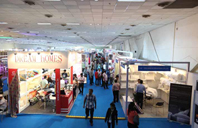
There is scarcely any other technology that has inspired textile manufacturers so much as digital textile printing. Reason enough to hold the ‘European Digital Textile Conference’ and to massively expand the ‘Digital Print’ segment. But what makes digital printing so special? Essentially, digital textile printing has three advantages: in the first place, the technology uses fewer resources, is cheaper and makes it possible to have faster production cycles. Secondly, textile designers can be much more creative and flexible when experimenting with high-quality forms and models. And thirdly, creators of home and household textiles are able to respond more quickly to the wishes of today’s consumers.
After all, there is certainly one thing that Heimtextil 2014 has already demonstrated: nowadays, consumers want to modernise their home textiles more frequently and give them a much greater individual touch. There is scarcely any other technology that combines brilliant colours, wonderful designs and production on demand with low resource utilisation. Sufficient reason to talk of one of the most important new technologies for manufactures of home textiles.
It is scarcely surprising therefore to learn that the market has been growing for many years. According to Textiles Intelligence the production volume of digitally printed textiles has been increasing by an annual 25 percent. Currently the share of digitally printed textiles in the entire market for printed textiles amounts to only two percent, but it is all set to increase to five percent by 2017. Currently, 60 percent of digitally printed textiles are produced in Bangladesh, India, Indonesia, Pakistan and Vietnam.
Second “European Digital Textile Conference”
An optimum overview of the subject is provided by the second ‘European Digital Textile Conference’. On the second day of the fair (15 January 2015), the World Textile Information Network (WTiN) and Messe Frankfurt are extending an invitation to participate in an English-speaking conference in Hall 4.0. This year it has opted for the following topics: market figures and trends, the advantages of digital printing over screen printing, new machines and technologies, printing on polyester, cotton and cellulose fibres, optimum colour management, the use of modern print heads and successful examples of digitally printed home textiles.
There was great enthusiasm for this year’s European Digital Textile Conference, from both the participants and the audience. I think everyone had underestimated the level of interest they would encounter at Heimtextil in this newly emerging discipline. It was natural that we would want follow it up with another edition in 2015,” says John Scrimshaw, textile expert and editor-in-chief of the magazine “Digital Textile”. “Heimtextil is the most important platform for trends in the home textiles sector and we can see that digital printing will be even more prominent this time round. Digitally printed home textiles present a huge opportunity and the technology is moving forward rapidly. The programme will reflect this progress, while also seeking to give insights into the commercial and creative possibilities of the technique.” The conference is divided into two subject areas: ‘Creative and commercial opportunities’ and ‘Technology for digital print.’
Heimtextil: Digital print to occupy a new, substantially enlarged product segment
At the same time, Heimtextil is very pleased about the substantial increase in the ‘Digital Print’ product segment. All the major players in the business have registered for 2015. Among them are HP, Reggiani Macchine, POD – Equipamenta, Durst Phototechnik, Kornit Digital Europe, Digital Graphics and J. Zimmer. According to the most recent figures there will be 13 exhibitors presenting their printing technologies (2014: six exhibitors).
Heimtextil welcomes Epson Europe as a new exhibitor in the ‘Digital Print’ field. “As a global event for the latest developments in home and contract textiles, Heimtextil provides the best opportunity to showcase the superb creative design and production flexibility of our latest inkjet printers and inks,” says Richard Barrow, Product Manager, Epson Europe. “With Epson inkjet technology it’s easy and affordable to produce bespoke interior decor products in stunning quality on-demand and in small quantities. At Heimtextil we will demonstrate contemporary fabrics and wall paper printed using a variety of Epson printers, also showing how our dye sublimation technology can open up new decor opportunities on a variety of surfaces such as glass, metal and plastic.”
Incidentally, to provide ‘Digital Print’ with more room for growth, this product segment will be moving to Hall 4.0 in the immediate vicinity of our Theme Park. So a visit to Hall 4.0 will be even more worthwhile!



























 沪公网安备31010402003309号
沪公网安备31010402003309号